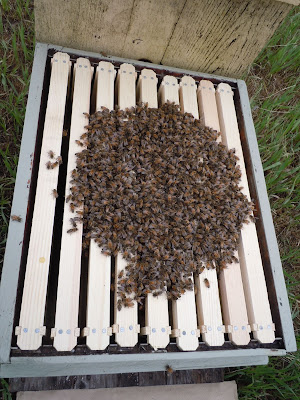This Columbus Day weekend Whitney and I had the pleasure of taking part in the 13th Annual, Apple Cider Making Party at the
GHJ Tree Farm! It was a beautiful day on the farm in the Santa Cruz Mountains of California where I grew up, and a wonderful time to catch up with family and old friends. It was Whitney's first Cider Making Party, and my first in many years, so it was a truly special day. Look for a blog post all about Cider Pressing coming soon.
While there we had our first (unofficial) honey tasting. One of the reasons I have always been pro honey bee is my good memories of having bee hives and honey when I was young. Years ago my Dad used to sell comb honey at his road side stand along with apples in the fall and Christmas trees in the winter. In more recent times, the bees were maintained for pollination, but not honey. Eventually with the onset of Colony Collapse Disorder and other pests and diseases, the bee hives went away.
Around the same time that Whitney and I became interested in bee keeping, my Dad also decided to return to bee keeping and purchased a package of bees. His first attempt didn't survive, but since then he has been successful, and this year for the first time in many years he harvested honey!
 |
| Our honey on the right and my Dad's GHJ Tree Farm honey on the left. |
One amazing thing about honey is the variation that can occur between hives. Color, taste and aroma (as well as length of time to crystallize) all depend directly on what plants the bees were feeding on when they filled the comb. Honey truly is a local crop, meaning that what is in the jar is a true representation of what is available within 3 miles of the hive (and often closer when flowers are plentiful). Like ours, my Dad's honey supers were pulled off the hive in the Autumn, so it is a summer honey, as opposed to a spring honey some people extract. Due to our location, our honey is likely a mix of wildflowers, flower gardens and vegetable gardens. It has a full rich flavor, that may come as a surprise at first but is very enjoyable. The GHJ tree farm honey, I suspect has much more wildflowers (weeds) and tree pollens in it due to the remote location. To me this dark amber honey had a light crisp flavor that instantly reminded my of Dad's honey of my youth. To mix things up further, we added a craft third honey, from
Snyders Honey in La Honda, CA.
 |
| The two Johnson honeys on the right and Snyders Honey on the left. |
Again, the light color had no impact on the flavor, which to me was mild and very pleasant, but taste is subjective so one person's sweet is another's mild.
What I do find interesting is that Americans seem to prefer lighter colored honey, so when the big honey houses bottle their batches, they mix it all together and shoot for a nice light to extra light amber like the Snyders Honey above, which is why that's what we are accustomed to seeing in the stores.
Honey colors are expressed in terms of mm according to the Pfund scale, so an Amber like ours has a range of 86 - 114mm, while a Dark Amber like my Dad's is >114mm and an Extra Light Amber like the one of the left is 30 - 50mm. In order to grade honeycolor , one uses a specially tinted piece of glass that has the scale printed on it from light to dark. Source:
http://www.honeybeesuite.com/the-color-of-honey/. Does this matter to the honey taster? Nope not a bit, I just find it interesting.
In any case, our first Honey Tasting was a lot of fun, made even more so since we could visit with family while enjoying! Take care everybody, and thanks for reading. KJ

















































